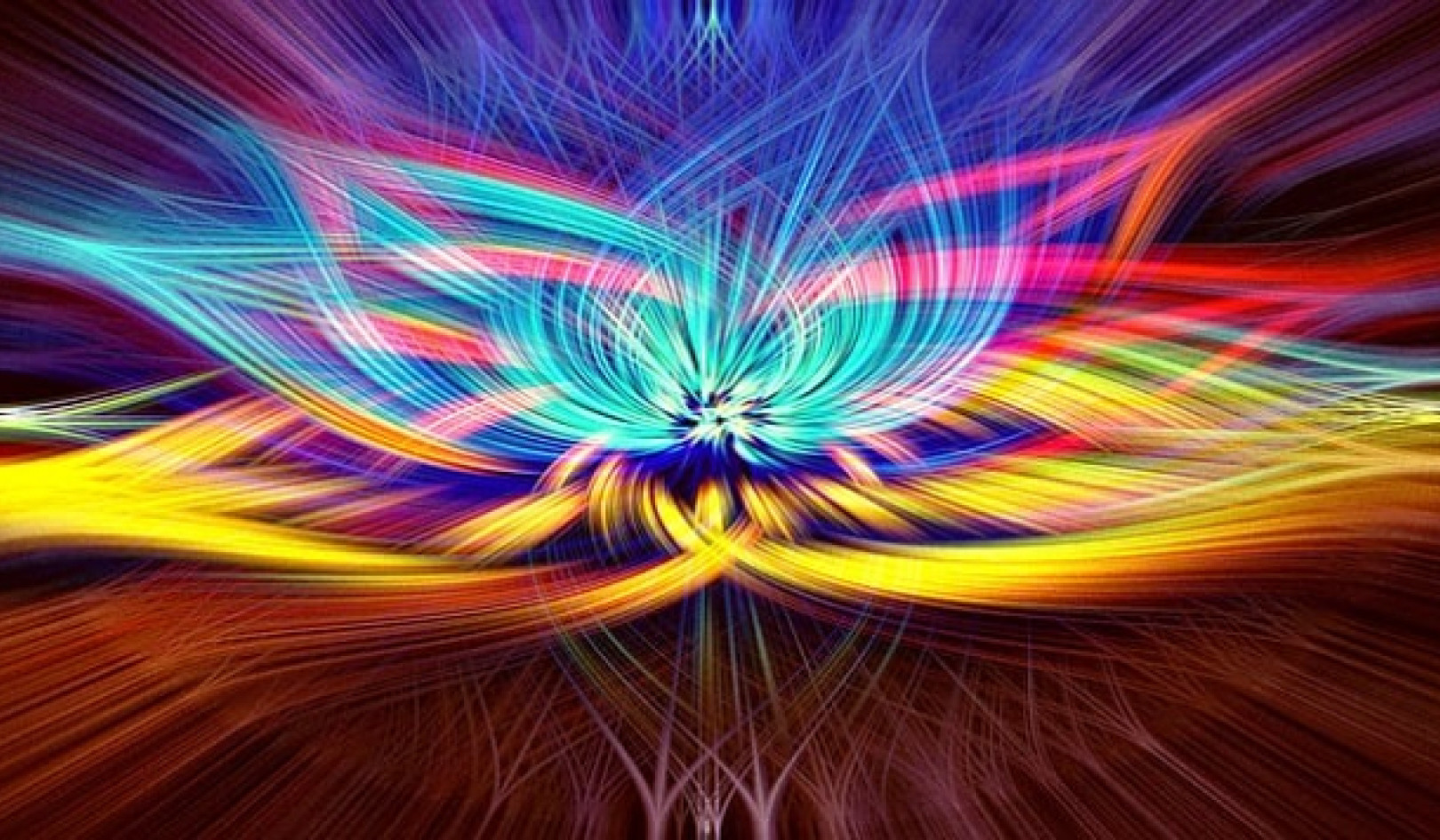
“Yogis are lazy,” says my mentor as we cruise by a yoga studio.
“But they do the hardest practices—getting up early, fasting, meditating all the time . . . how can they be lazy?” I remonstrate.
“These are shortcuts to enlightenment. Yogis do them because they don’t have time to mess with stuff that takes forever. You know, they’re lazy.”
Being spiritual doesn’t mean that you have to meditate in a cave eight hours a day or leave your family for a convent. It doesn’t depend on brain-enhancing contraptions or the money you give to a church, because spirituality is inherent in you—it’s free and easy to cultivate. Spiritual masters from around the world, including Christ, Moses, and the Buddha, enriched their lives by investing in the dividends of an awakened inner abundance.
Like a mirror, your soul reflects the pure light of the Divine. But over time every mirror becomes dusty—caked and encrusted with the negative conditioning of material reality. Eventually, without attentive upkeep, it may become so grimy that it reflects little to no light. This is when we feel depressed, materialistic—even mean and violent. We see the mud and not the mirror. We identify with the grime, not knowing that just below it the mirror is there, ready to reflect the sun and shine if we only give it a chance.
Cleaning The Wound
Did you ever get a cut? What was your job to make sure it healed? Did you actually do any healing, or did you simply clean the wound and allow it to heal itself?
Letting spirituality shine through you is the same—your job is to clean the junk getting in the way, letting the light do its work. That light is the reality of your true self. The only difference between “spiritual” and “material” people is how encrusted their mirrors have become, for all mirrors shine equally when they’ve been cleaned and polished.
It’s no accident that spiritual traditions at their core teach similar truths—that love and compassion are closer to your true nature than fear and selfishness; that light triumphs over darkness; that the essential part of us is immortal, joyful, and free. “Well, that’s all fine and good,” you may say, “but it’s not how things work in the material world where we have to fight to put food on the table.”
It’s true. In the dog-eat-dog reality of bills and daily survival, love and compassion may seem out of reach. But your spiritual nature is closer than you think and available to you 24/7 if you know how to summon it. And you don’t have to be a yogi or a nun to do so.
Purity
In Sanskrit, one of the oldest languages in the world, the word sattva means “beingness”—one’s essential state. This natural state is one of purity, harmony, and balance, and it’s the glow you see in saints around the world. From Christ to Krishna, the halo surrounding these enlightened icons is sattva—the light of spirit suffusing the material self. Our goal is to return to that state by removing the grime that keeps our purity from shining through.
The Sanskrit term for this grime is tamas, the opposite of sattva, which also means “dullness, depression, and darkness.” Tamas is the mud that clogs our spiritual channels and blocks our light. There are tamasic and sattvic people, places, foods, and even times of day.
It is said that the Buddha’s aura of sattva was so powerful that anyone within fifty miles of him became calm and meditative. Children stopped fussing, and mothers stopped fretting. Farmers dropped their yokes to sit and contemplate. Whole villages came to inquire about the source of their calmness. In fact one of the ways to kindle your sattva is to sit in the company of those in whom it already shines brightly. Like a torch lighting others, that flame can ignite your inner spark of divinity.
That’s because this halo, the light in enlightenment, doesn’t belong only to saints and martyrs—it also belongs to you. By shedding the layers of darkness that stand in its way you can get in touch with your own personal splendor.
Purity is not a finite resource like water or food, to be hoarded and saved. Though precious, it is free; though priceless, it is abundant, unburdened by the material imperatives of supply and demand—scarcity and drought. The only question is how to realize it. A master named Yeshua (Jesus) said, “My yoke is easy and my burden is light.” How right he was! By practicing the principles taught in the Dharma Method every day you can be the source of your own enlightenment.
“What is enlightenment?”
“It is seeing things as IT IS.”
“What do you mean?”
“In the dark, you mistake a rope for a snake, a lamppost for a stranger. But turn on the light, and snake and stranger disappear. Where did they go?”
“I don’t know.”
“They were never there in the first place. They are illusion, fabrications of the mind. So it is with most things.”
“So enlightenment is seeing things as they are?”
“Enlightenment is seeing things as IT IS!”
“I still don’t understand . . .”
“It’s okay, it will come . . .”
What’s So Special about Sanskrit?
You may wonder why we use words like sattva when we could just say purity, light, and balance. It’s not to be pretentious—it is because Sanskrit was designed to describe spiritual states perhaps more precisely than any other language on Earth. Your Volkswagen Golf may be fine for tooling around the city, but to cross the Baja Desert you need a vehicle specially equipped for that purpose. Sanskrit is the all-wheel drive truck engineered to deftly traverse the spiritual terrain, and English has already borrowed from it. The words guru, pundit, karma, avatar, chakra, mantra, and yoga, for instance, are all part of the English lexicon.
While words like nirvana, moksha, and samadhi all translate to “enlightenment,” that’s because we only have the word enlightenment in English to describe the varying nuances of the spiritual experience. Moksha literally means “release” and is the general term in Hinduism used to suggest release from the bonds of attachment. Nirvana is a Buddhist term that means “without disturbance,” and samadhi comes from the yogic tradition meaning “complete absorption.” All three describe subtle levels of awareness and together correspond to what most of us consider enlightenment.
Enlightenment
Enlightenment may mean different things to different people. It’s both “the process of becoming lighter” (as opposed to carrying the heavy burden of accumulated grime) as well as being “bright and shiny” (as opposed to lurking in the dark). Both meanings are interchangeable when it comes to spirituality. Dropping the heaviness of a toxic colon, for example, by fasting or cleansing can lead one to see the world in a brighter light.
However, most simply put, enlightenment means becoming “a light unto yourself.” When it’s dark, it’s easy to mistake one thing for another, like a rope for a snake. But when the light’s turned on, the snake disappears. This is seeing the truth of our existence, which is suffused with beauty, peace, and love. But don’t take my word for it: here’s a summary of the eleven principles that will help you experience it for yourself.
- Timing: choose the best times of day to charge your spiritual batteries
- Breathing: make your body light and your mind translucent
- Carving out time for the spirit: active and passive meditation
- Eating blessed food: foods for cultivating purity in body and mind, when to eat them, and how to sanctify your meals
- Sacred speech: cultivating sound for a standing wave of good vibrations
- Sacred movement: turning any exercise into spiritual practice
- Honoring the elements: harness the purity in nature
- Fasting: get the most from the oldest spiritual discipline in the world
- Making your home a temple: creating space for the Divine
- Sharing good company: gods, dogs, and kids
- Doing your dharma: give your unique gift to the world
©2018 by Simon Chokoisky. All Rights Reserved.
Reprinted with permission of the publisher, Destiny Books,
a division of InnerTraditions Intl. www.innertraditions.com
Article Source
The Dharma Method: 7 Daily Steps to Spiritual Advancement
by Simon Chokoisky In this practical spiritual guide, Simon Chokoisky shares 11 time-tested yet simple daily techniques to help you find your spiritual path, or “dharma,” no matter what your spiritual background -- be it Christian, Hindu, Buddhist, or Agnostic. He explains how everyone has a unique learning style as well as a spiritual style -- your “Dharma type” -- and how the Dharma method allows you to pick any seven of the 11 methods described in the book to practice. You can even change them daily, all based on your unique needs. And by holding to the 7/11 “rule” daily, you’ll soon find yourself on the road to rapid spiritual progress and personal enlightenment.
In this practical spiritual guide, Simon Chokoisky shares 11 time-tested yet simple daily techniques to help you find your spiritual path, or “dharma,” no matter what your spiritual background -- be it Christian, Hindu, Buddhist, or Agnostic. He explains how everyone has a unique learning style as well as a spiritual style -- your “Dharma type” -- and how the Dharma method allows you to pick any seven of the 11 methods described in the book to practice. You can even change them daily, all based on your unique needs. And by holding to the 7/11 “rule” daily, you’ll soon find yourself on the road to rapid spiritual progress and personal enlightenment.
(Also available as an Audiobook and as a Kindle edition.)
About the Author
 Simon Chokoisky is a pioneer in using Vedic Astrology and Dharma Typing to help people discover their soul’s purpose. He runs a private consulting business based on his trainings in Vedic life mapping and Vedic Astrology. The author of The Five Dharma Types, Gambler’s Dharma, and Sex, Love, and Dharma as well as the creator of the Decoding Your Life Map with Vedic Astrology DVD series, he travels widely conducting seminars. Visit his website at http://spirittype.com
Simon Chokoisky is a pioneer in using Vedic Astrology and Dharma Typing to help people discover their soul’s purpose. He runs a private consulting business based on his trainings in Vedic life mapping and Vedic Astrology. The author of The Five Dharma Types, Gambler’s Dharma, and Sex, Love, and Dharma as well as the creator of the Decoding Your Life Map with Vedic Astrology DVD series, he travels widely conducting seminars. Visit his website at http://spirittype.com
Video with Simon: Introduction to Dharma...
{vembed Y=b4Vor9N-NBA}
Books by this Author
at InnerSelf Market and Amazon

























